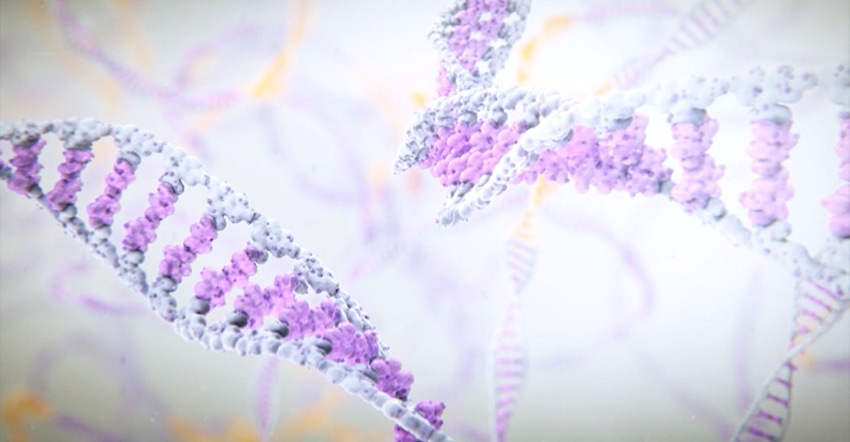Merck leverages innovation purchase to create Sequivity, a tech called ‘biologicals of the future’.
June 7, 2018

By Willie Vogt
The goal of swine health is to keep pig herds productive and deal with the diseases impacting those animals quickly. There’s a movement in the industry to develop custom vaccines targeting specific diseases in individual herds in new ways. During the 2018 World Pork Expo, Merck rolled out Sequivity — a tech the company calls “biologicals of the future — available today.”
In November 2015, Merck purchased Harris Laboratories in Ames, Iowa. This innovative firm was pioneering the use of RNA tech to develop vaccines for specific needs. Merck is leveraging that technology with its new Sequivity product line which allows producers to address specific instances of herd diseases and develop customized solutions.
Joe Roeder, director, swine technical service for the United States, at Merck, says that the company is “excited about the Sequivity technology.” He explains the tool is a “power tool” for the tech service team and allows the veterinarian to work with the producer to create a specific response to diseases in the herd.
The value of vaccination cannot be underestimated with the goal of achieving herd health. Roeder says, “Prevention is the key to success and the diseases we prevent are the ones that allow us to grow pigs to feed people.”
What’s evolving in swine health is the ability to better understand the genetic base of viral and bacterial infections that impact herds. With that information, it’s now possible for researchers to target very specific infections with tools that can provide immunity for a farmer’s herd. Sequivity is that precision vaccine technology that aims at the exact gene-causing part of a specific herd infection.
Kim Crawford, swine tech services veterinarian, Merck, explains that the new tool is flexible, allowing the veterinarian to prescribe a custom solution; it’s precisely because it specifically zeroes in on a genetic portion of the target disease and it is safe because no actual disease material is involved.
A key example, which comes from the Harris Labs history of the tech, is porcine epidemic diarrhea virus. The disease, which created nightmares for the industry, was a significant challenge. Using the RNA particle technology, the company developed a vaccine for the market by August 2015. That vaccine is still available from Merck for the disease.
How it works
Sequivity uses Particle RNA, which means that no part of the disease is used to make the vaccine. Instead, the veterinarian sends a sample of a specific disease to a Merck lab. The disease is run through a test that identifies the Gene of Interest. This GOI is essentially the key to developing proper antigens to that disease in the target animal.
The GOI is sent electronically as a code to the lab for creation of the vaccine. No biological material is sent, instead, the code built from the key amino acids of the disease get sent to the lab. The GOI is synthesized and inserted into the RNA production platform at the company.
After incubation, RNA particles released from the production cells are harvested, purified and formulated into a final vaccine. This vaccine creates the necessary antigens in the pig when injected, protecting the animal from the target disease.
Sounds simple, but it’s a process that has taken years to refine. Merck has carried the historical library of Harris Labs genetic material forward, and along the way its researchers have built up a library of GOIs for key diseases, creating vaccines for influenza, rotoviruses, porcine reproductive and respiratory syndrome, PEDV, E. coli, and more. It’s a growing list.
This tool allows for rapid response. While the PEDV example shows that the company can move quickly, Crawford adds that it’s possible in as little as six to eight weeks to develop a targeted vaccine for a disease — bacterial or viral — impacting a particular herd.
Brett O’Brien, Merck tech services veterinarian, explains that the cost of the vaccine depends on a range of factors. “Keep in mind this is a customized vaccine and we’re working with veterinarians to develop each product,” she says. “The price will reflect the needs of the vaccine.”
Mapping disease
One tool Merck will bring to this Sequivity effort is the ability to geo locate diseases. O’Brien and Crawford explain that this new tool will power a data dashboard from Merck that can provide local veterinarians a “heads up” about incoming diseases.
Crawford says: “This tool can be used to map incidence of disease, including genetic information, popping up in a specific area. That can be used to alert the local veterinarian of potential issues.”
O’Brien adds: “This tool can help alert veterinarians to threats coming into an area.”
Mapping disease will allow Merck to better match solutions to problems. A vaccine might be developed for one farm’s incidence of disease, but find that the same disease is popping up in other parts of a region. This new dashboard is just coming online but bears watching because it could show how disease spreads in a “real-world” population.
You can learn more about Sequivity technology at Sequivity.com.
You May Also Like



